15 May / A Chat with Leela Punyaratabandhu of SheSimmers.com and “Simple Thai Food” Cookbook Giveaway
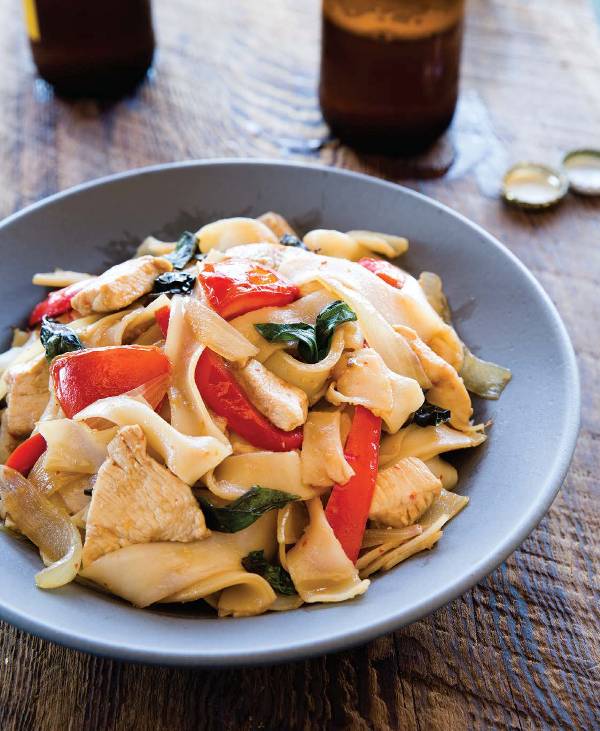
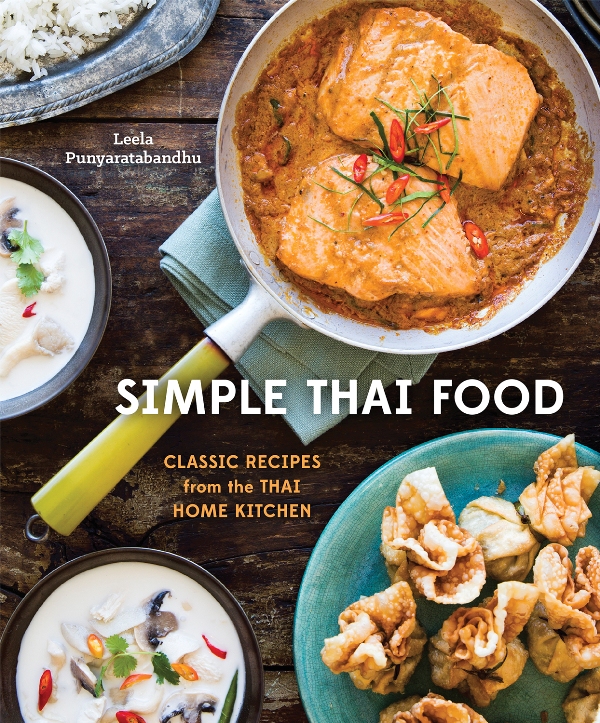
Simple Thai Food was released in May 2014 and will surely be a perennial guide for anyone who wants to cook classic Thai food at home.
Leela Punyaratabandhu is the lyrical voice behind the award-winning Thai food blog SheSimmers.com. Her debut cookbook Simple Thai Food–Classic Recipes from the Thai Home Kitchen (Ten Speed Press, May 2014) was released almost exactly one year ago on May 13.
To celebrate her book’s first birthday, I asked Leela to share her thoughts on everything from cooking as a new transplant to the U.S. to the evolution of American Thai restaurants, as well as her book writing and research process. Plus, her publisher, Ten Speed Press, is giving away a copy of Simple Thai Food!

Leela Punyaratabandhu is the lovely lady behind the Thai food blog SheSimmers.com (Photo credit: Chris Cham)
1. What were some of the first few dishes you tried to recreate when you first came to the U.S. Did you have trouble finding ingredients?
Tom kha kai was one of the first few dishes I tried to recreate, because it’s one of my favorite things to eat in the whole world, Thai or otherwise. I didn’t think it was going to be a big deal.
Back home, you could whip up a pot—for company even!—at a moment’s notice, and it would be done in less than 30 minutes. Here, just hunting for the essential ingredients (namely lemongrass, galangal, and kaffir lime leaves) would sometimes stretch over the course of 3 to 4 days. One grocery store might have lemongrass but not kaffir lime leaves. Another store might have galangal and kaffir lime leaves but no lemongrass. Yet another store might have everything but the galangal looked like it was harvested during the Clinton administration.
So, in the end, I had to settle for bottled tom kha paste and reinforce it with whichever of the three fresh herbs I could find or afford that day. I spiffed it up with fresh lime juice, fresh chilies, and fresh cilantro. I also used fresh assorted wild mushrooms in season. It was quite good.
2. You started your blog in homage to your mom. Did you ever in your wildest dreams think SheSimmers.com would become an award-winning blog read by thousands of people and that you would write your own cookbook?
Oh, heck no. I was too heartbroken from my mother’s death and a few other things that took place around the same time to even think about that sort of thing. I didn’t even say to myself that I would create a Thai cooking blog, and in the beginning, I blogged about a bunch of non-Thai dishes.
The idea was to share with people the recipes that I made for myself at home, and I don’t just make Thai food at home. It wasn’t until about a year later that I realized my readers actually wanted me to focus on what they felt I did best: sharing what I know about Thai food and how to make it in the American kitchen.
With the cookbook, though, I’ll admit I had always harbored a secret dream of writing one since I was a child. I even handwrote one, photocopied it, and forced my friends and cousins to take one copy each.
Actually, I would say that the idea that later became Simple Thai Food had existed in my mind years ago but remained buried. I had no plan of pursuing a book project.
Things came together, because a few publishers contacted me, and, in the end, I decided to partner with Ten Speed Press. Next thing I knew, I hid myself for months in a library in Bangkok writing Simple Thai Food.
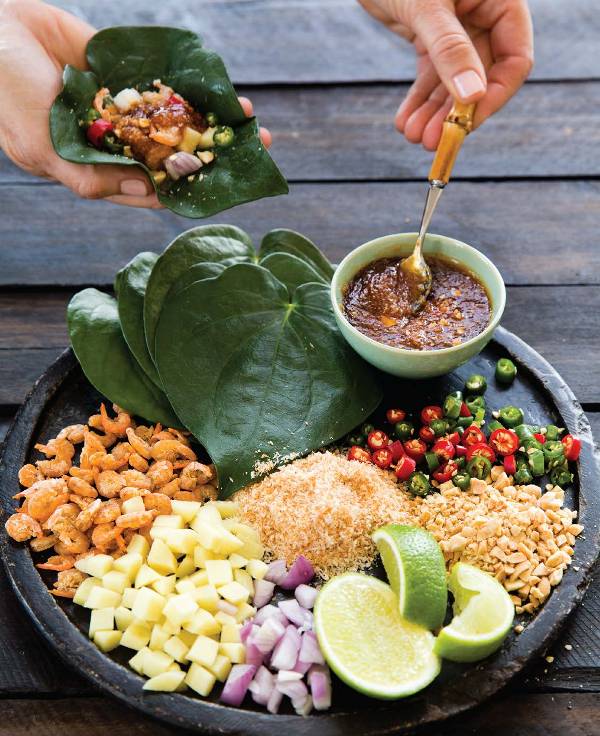
Leaf Wrapped Salad bites (Photo credit: Erin Kunkel)
3. How do you think Thai food in U.S. restaurants differ from that in Thailand? I‘ve been seeing a movement toward more authentic replications (no more ketchup in pad Thai!). Do you agree and if so, why do you think this is happening?
I agree. The gap between the way Thai food as made and presented in Thailand and Thai food as made and presented in the U.S. has arguably become smaller and smaller with every passing year. I think it’s largely because Americans have become more knowledgeable about and more open to the different cuisines of the world (through international travels, travel and cooking shows, travel blogs and food blogs, and, in the past few years, social media sharing). This has resulted in a greater demand for Thai food the way it’s made in Thailand which means Thai chefs are becoming unshackled and their true talent unleashed.
Years ago, the boldest move Thai restaurants would do was to make some lesser known, boldly-flavored, regional Thai dishes available to Thai patrons or a handful of American diners to order off the menu—you know, the so-called ‘secret menu.’ However, within the last few years, we’ve seen these secret-menu items permanently moved to the regular menu, because they have proved to be popular enough (years ago, this would have been a bad move on the restaurant’s part financially).
Even though this phenomenon is still currently limited to large metropolitan areas in the U.S., you can see that within the next few years, regardless of where they’re located, Thai restaurants that insist on making phat thai with ketchup will go the way of the dinosaur.
The enthusiasm of new-generation American diners is a good thing. Not only does it embolden Thai restaurants to push the limits, but it also turns on the green light for both Asian and mainstream supermarkets to stock up on ingredients once considered esoteric and used by too few people. As a food writer and cookbook author, I can tell you that this has certainly made my job easier not to mention more fun and rewarding. Everyone benefits from it.
4. What is your goal with the cookbook? What do you want your readers to get out of it?
It’s more to show people that it’s easy to recreate Thai dishes at home. I wanted people to know that most Thai home cooks don’t like to make things too complicated in the kitchen either.
The key is to know the basics so well that nothing is intimidating to you anymore. Simple Thai Food is a beginner’s guide, a collection of entry- to -mid-level recipes for well-known Thai dishes which are easy to make (or have been simplified and streamlined so that they’re now easy to make) and don’t require special equipment or cooking skills matching those of professional cooks or street vendors. It seeks to build a solid foundation on Thai cooking, giving people what they need to know without weighing them down with detailed information.
Through my interactions with my readers over the years, I’ve come to see that there are many Thai food fans who are enthusiastic about replicating their favorite Thai dishes at home but may not always be sure whether they have what it takes. Simple Thai Food’s mission is to show them that yes, they do have what it takes.
An American classmate of mine, back when I was still in school, asked me years ago if there was a book that curated everyday Thai recipes that would take someone like him from not knowing much about Thai cooking to being able to say that he was a bona fide Thai home cook. This question was on my mind the whole time as I was writing this book. I had to make sure the recipes were easy, and, at the same time, I had to make sure they were real, existing dishes that the Thai people knew and consumed all the time. I had no intention whatsoever of making up new Thai-inspired dishes. That would have made the task of writing this book a heck of a lot easier, but it wasn’t an option since my goal was to present a collection of classic dishes that were simple enough for beginners.
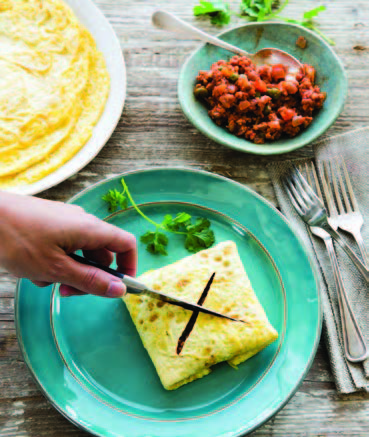
Stuffed Egg Crepes (Photo credit: Erin Kunkel)
5. You’ve included plenty of favorites like pad Thai, tom yam soup, and spicy basil chicken that Americans are generally familiar with. What do you think might be some of the more “challenging” dishes?
I don’t think there’s anything in the book that those new to Thai food would find “challenging,” i.e. an acquired taste. Some may find fish sauce-marinated fresh shrimp with spicy lime dressing (kung chae nam pla on page 30) challenging, because the dish is served raw, but, if they think about it, it’s actually not any different from sushi or sashimi.
Another one that may be challenging is Shrimp Paste Rice (khao khluk kapi on page 137) which is something Thai restaurants in the U.S. rarely serve but is very commonly found in Thailand, especially Bangkok. Shrimp paste can be a bit strong for some people. In most Thai curries, it’s used in very small amounts to create a deep and complex layer of flavor; it’s not right in your face, but you know it’s there.
When it comes to Shrimp Paste Rice, however, shrimp paste is a featured ingredient, and its taste is brought to the front and center. So, this could be too strong for some people. That said, good shrimp paste isn’t supposed to be overly salty and pungent. Unfortunately, I still haven’t found any brand of Thai shrimp paste in the U.S. that is anywhere as good as the shrimp paste I get from seaside towns in Thailand.
So, to mitigate its effects, I have you fry the paste in oil first which helps take away some of the edge. My grandmother would have just mixed the uncooked shrimp paste right into the rice.
There are, however, a handful of dishes that may be ‘challenging’ not because of its taste or smell but more because of the way it’s consumed which doesn’t have an equivalent in the Western way of eating. For example, the shrimp-coconut relish with vegetable crudités (lon kung mu sap on page 109). The concept of a relish as a rice accompaniment is already quite foreign—not to mention the concept of composing a bite of food that consists of rice, relish, and a piece of raw vegetable to form a chopped salad of sorts in your mouth when you chew them together. But that’s very much what traditional Thai food is.
6. Curry paste: To make, or not to make from scratch?
Do what works best for you—that’s what I tell people.
Of course, everyone knows and agrees that freshly made, from-scratch curry paste is better than curry paste from a tub or a can. But the ingredients you need to make a proper curry paste aren’t always easy to find.
I’m not a curry-paste snob, although I know that whenever I invest time and money in making curry paste from scratch, I’ll be greatly rewarded. If you’re going to be snobbish about curry paste—oh, man—there are so many ways one can get snobbish about it. Even among those who insist on fresh, from-scratch curry pastes and nothing else, there are those who say unless you make it in a mortar, it’s not a good curry paste, so they look down on those who use a blender or food processor.
To sum up where I stand on this issue, I’ll say this: fresh is always best. But fresh must mean you use the right ingredients, leaving out nothing important, and not making poor substitutions. If you find yourself having to leave out a few ingredients or replace them with things that don’t even taste like them, then your fresh paste won’t yield what most Thai people would consider good. If the true taste of Thai is what you’re after, then you’re better off with a ready-made paste.
There’s no shame in using a ready-made paste, by the way. Walk around a fresh market in Thailand, you’ll see mountains (vendors really shape them that way—like a mountain or a wide cone) of assorted curry pastes ready to be used. This means home cooks in Thailand use ready-made pastes, too. Do they know how to make a paste from scratch? Of course, they do. But they don’t think you need to make a paste from scratch every time you want to make a curry. These days, there are more and better brands of curry paste from Thailand available in the U.S. market. Why not take advantage of them?
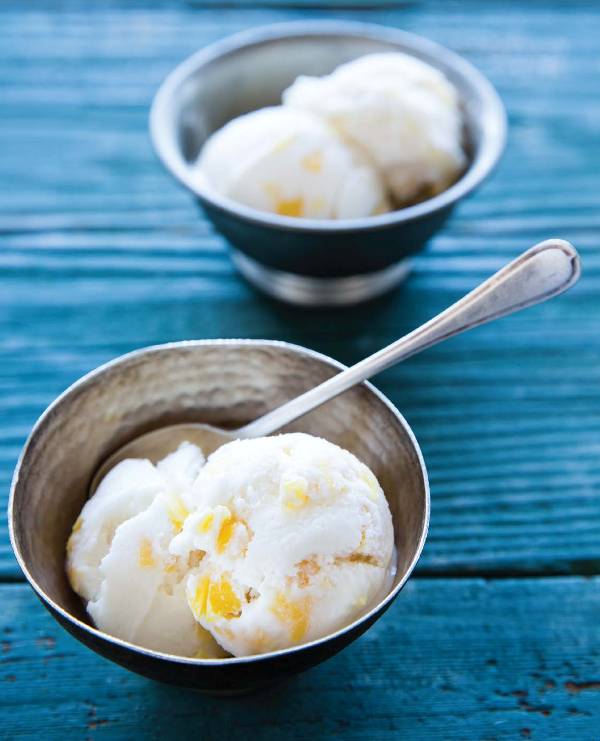
Ice Cream with Jack Fruit (Photo credit: Erin Kunkel)
7. When I flip through a new cookbook, the ones that catch my eye are the ones that have photos attached. Are there any dishes in the book that don’t have photos that you think are must-tries?
Some of my top favorite dishes to make and eat are found in the One-Plate Meals section. Rice noodles with beef and Chinese broccoli is something that I think a lot of people will like. Rice noodles with beef-tomato gravy is another favorite of mine. It’s so easy and quick to make as well as kid-friendly.
Many may have a hard time visualizing rice congee with pork dumplings and eggs, but it’s a thick, silky, comforting savory rice porridge that is pretty addictive. Chicken and fried garlic on rice is one of the most frequently requested recipes from my readers who have been to Bangkok and tasted this simple but delicious dish.
Lastly, chicken in brown sauce on rice is something I highly recommend. It’s a dish I used to make all the time when I was a student, because it was inexpensive and quick to make. It’s one of those things that you don’t normally see on most Thai restaurant menus, but this is an old-school dish that Bangkokians have loved for generations.
8. In addition to family recipes, how did you find recipes to include in your book?
I’d already had a pretty good idea what dishes to include in Simple Thai Food when I set out to write it. Since I knew that I would stick very closely to the existing, classic dishes and that I wouldn’t riff at all, I didn’t even have to think up or go hunting for new recipe ideas. It was just a matter of compiling the ones I’d already made hundreds of times before that I believed were easier than the rest. Then I streamlined them further, allowed substitutions when possible, and sent them off to my recipe testers.
It was actually in the streamlining stage that the things I’d learned from different people, including street vendors, came in handy. When integrity of the cuisine is one of the goals, you can’t simplify or substitute willy-nilly, you need to know what represents the core—the soul—of each dish that is the part that must not be compromised. Then you make everything that can be removed optional and offer different ways for people to arrive at the same destination.
Take, for example, the previously mentioned rice congee recipe. You could, if you want to, start from zero by boiling up some rice until you get a thick, soupy porridge and proceed from there. But that would more than double the amount of time it takes to make this dish (many recipes I have seen have you do that—not that there’s anything wrong with them).
Now, if you walk around Bangkok and observe how jok is really made by street vendors, including the one I interviewed, you will notice that every single one of them makes a huge pot of very wet rice in advance and scoop out a portion of it to make an individual serving to order. This means, at home, people should be able to start out with leftover cooked rice as well. So, why not do that?
Also, another trick of the trade that I have learned from a couple of jok vendors I’ve talked to is that when you mix some glutinous (sticky) rice into long grain rice, it results in thicker and silkier congee that is also a bit more heat stable and remains viscous longer due to the higher amounts of amylopectin in glutinous rice. So in that huge pot of rice they make in advance, there’s already some sticky rice in there.
But at home, it’s more practical to use the leftover long grain rice you already have (that old box of rice from last night’s Chinese takeout?), then introduce amylopectin to the congee in the form of tapioca starch or glutinous rice flour (or even cornstarch). This explains why I wrote the recipe that way. Why do it the hard way when an easier, quicker way gets you to the same destination? It takes me years of eating out, observing, talking to people to learn all these tricks.
Disclosure: As research for this interview, I was given a complimentary copy of Simple Thai Food, however, all opinions are my own!
~~~
COOKBOOK GIVEAWAY
For a chance to win a copy of Simple Thai Food, courtesy of Leela’s publisher Ten Speed Press, please subscribe to the Pickles and Tea blog (scroll down to the very bottom!) and tell us about your favorite Thai food experience or dish in the comments section below. We’ll randomly select a winner and post the results after the deadline.
Last day to enter: Friday, May 29th 2015.
Sorry, but we can only mail to U.S. and Canadian addresses.
~~~
[yumprint-recipe id=’9′]





My lightbulb moment with Thai food was many year ago on my first trip to London. I don’t remember what the name was but it was spicy and had coconut milk and keffir lime leaves (I believe) in it. It was worlds different than anything I’d had before in rural southern California. And Thai ice tea, which I always wonder if it’s really authentic Thai…
I love Leela’s blog and would love her cookbook! I’ve tried several recipes from her website and love most the hainan chicken, the sauce is amazing! Her noodles, curries, and desserts recipes have all been been winners in our household. Simple yet full of flavor. Keep it up!
I truly fell in love with Thai food during a vacation to Thailand. My family took a Thai cooking course in Chiang Mai and really enjoyed learning to cook some of our favorite foods. Thank you for the interesting interview and awesome giveaway!
I love pad kee mao/drunken noodles. Since there’s not a Thai restaurant near me, I’m going to try Leela’s recipie!
Realizing I could make Thai curry at home that was comparable to what I can get locally at a restaurant, for way cheaper, was awesome. My local grocery store starting to carry Mae Ploy curry paste so I didn’t have to drive and hour and a half to get it was even better.
Larb Moo is my favorite Thai food
It was when I read that it was okay to use store bought curry paste (in a tin can) and enjoy eating home cooked curry regularly.
Making friends with the local owner of our city’s only Oriental market. Once we started talking food, she steered me towards many ingredients I would never have known to try. She helped me feel confident enough to try making my favorite dish in the world, Pad Thai. Unfortunately they have closed, but I am willing to travel to find what I need. I actually think I have been looking for this cookbook for a long time! I also want to try Tam Yom Soup. Yum
I did an exchange program in college and lived in Thailand for seven months. my favorite thai food experience was eating som tom with sticky rice for dinner *almost* every single night (for seven months!) at a local open air market by my apartment. so so spicy, and so so good!
When i realized that i can make my own larb gai and thai cucumber salad, i found the confidence (and the ingredients) to try other favorite thai dishes. now i can make most thai restaurant staples at home and love it!
Favorite dish to make with family and friends is Curry Pumpkin and Vegetables. Jar of TJ’s Curry sauce, canned pumpkin with stir fried veggies and potatoes over brown rice is quick and yummy.
Sounds delicious! TJ’s is great for prepared sauces, I use them often.
Sounds delicious! TJ’s is great for prepared sauces (and most stuff really), I use them often.
Cooking Thai at home CAN be quick and easy! TJ’s products are pretty tasty aren’t they?
Too many favorites. Red ruby, fish cake, duck green curry, Tom yum goong, olive fried rice, pineapple fried rice.
I’m with you there, Diana. I can’t just pick one favorite dish!
I love so many Thai foods…from the curries down to the mango salads …in the summer I love to grill chicken satay. I think my greatest joy is discovering new foods and recipes to cook, now that I am brave enough and have discovered that I really can do this ! For some reason I used to think that Thai cooking was something that would be impossible to reproduce…I am so glad I saw the light because I really enjoy discovering new Thai dishes.
Laura, so glad you’ve discovered that you can really make anything you put your heart to. Happy cooking!
I was traveling thru SE Asia on a shoestring. My first night there I went crazy ordering wonderful Thai food. When the bill came my heart sank; I had spent $50 on one (big, delicious) dinner! Then I realized my math was off, and it was actually $5!!!
Hah! Funny story, thanks for sharing :).
My mom is Thai, and I used to watch her make these little pork, cured radish and peanut-filled tapioca dumplings that we ate with fried garlic in oil, fresh Thai Bird chiles, lettuce leaves and cilantro. The Thai name for these dumplings is “Saku Sai Muu.” I could eat a lot of these on my own if I wasn’t careful, I love them so much! Thai vendors never pack many of them per package, so I’d usually have to buy several and be rather selfish about sharing: One for you, THREE for me!
Apparently, I’m not that skilled, because despite having my mom’s recipe, when I tried making them myself by steaming them, they came out rather deflated looking, and not so round as they should be. Someone (Thai) told me to try dropping them in boiling water instead of steaming them if I wanted them to stay round, so I’ll try that, on my next attempt. Wish me luck!
Yum! Those dumplings sound delicious. I know what you mean, I can never make my mom’s dishes as good as she does. Let us know if boiling them worked out better than steaming.
And the winner is … Diana!!! Congratulations! Thank you everyone for participating!